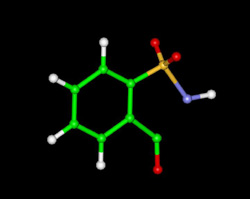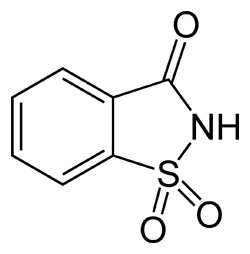 |
Saccharin is the oldest artificial sweetener; it was discovered in 1879 by Ira Remsen and Constantin Fahlberg of Johns Hopkins University.
- Usage note: The word saccharin has no final "e". The word saccharine, with a final "e", is much older and is an adjective meaning "sugary". Both words are derived from the Greek word (sakcharon, German ch sound), which ultimately derives from Sanskrit for sugar, sharkara), which literally means gravel [1]. The word's connection with sugar means the term is used metaphorically, often in a derogative sense, to describe something "unpleasantly over-polite" or "overly sweet".
Saccharin is about 300 times as sweet as sucrose, but has an unpleasant bitter or metallic aftertaste, especially at high concentrations. This unpleasant taste is criticized in the novel Nineteen Eighty-Four by George Orwell, We The Living by Ayn Rand, and the song "Bad Cover Version" by Pulp. Unlike the newer artificial sweetener aspartame, saccharin is stable when heated, even in the presence of acids, does not react chemically with other food ingredients, and stores well. Blends of saccharin with other sweeteners are often used to compensate for each sweetener's weaknesses. A 10:1 cyclamate:saccharin blend is common in countries where both these sweeteners are legal; in this blend, each sweetener masks the other's off-taste. Saccharin is often used together with aspartame in diet fountain beverages, so that some sweetness remains should the fountain syrup be stored beyond aspartame's relatively short shelf life.
In its acidic form, saccharin is not particularly water-soluble. The form used as an artificial sweetener is usually its sodium salt. The calcium salt is also sometimes used, especially by people restricting their dietary sodium intake. Both salts are highly water-soluble: 0.67 grams per milliliter water at room temperature.
Discovery and history
Saccharin's sweetness was accidentally discovered by Ira Remsen, a professor at Johns Hopkins University, and Constantin Fahlberg, a research fellow working in Remsen's lab. In 1879, while working with coal tar derivatives (toluene), Remsen discovered saccharin's sweetness at dinner after not thoroughly washing his hands, as did Fahlberg during lunch. Remsen and Fahlberg jointly published their discovery in 1880 [1]. However, in 1884, Fahlberg went on to patent and mass-produce saccharin without ever mentioning Remsen. Fahlberg grew wealthy, while Remsen merely grew irate. [2] On the matter, Remsen commented, "Fahlberg is a scoundrel. It nauseates me to hear my name mentioned in the same breath with him".
Saccharin was an important discovery, especially for diabetics. Saccharin goes directly through the human digestive system without being digested. It does not affect blood insulin levels, and has effectively no food energy.
Although saccharin was commercialized not long after its discovery, it was not until sugar rationing during World War I that its use became widespread. Its popularity further increased during the 1960s and 1970s among dieters, since saccharin is a calorie-free sweetener. In the United States saccharin is often found in restaurants in pink packets; the most popular brand is "Sweet'N Low". A small number of soft drinks are sweetened with saccharin, the most popular being the Coca-Cola Company's cola drink Tab, introduced in 1963 as a diet soft drink.
Chemistry
The image below shows the chemical structure of saccharin C7H5NO3S

Saccharin can be produced in various ways. Remsen & Fahlberg's original route starts with toluene, but yields from this starting point are small. In 1950, an improved synthesis was developed at the Maumee Chemical Company of Toledo, Ohio. In this synthesis, anthranilic acid successively reacts with nitrous acid, sulfur dioxide and chlorine, and then ammonia to yield saccharin. Another route begins with o-chlorotoluene. (Bungard, 1967)
Saccharin and cancer
There have been worries about the safety of saccharin since its introduction. Even when Theodore Roosevelt was President of the United States, there was intense questioning regarding the safety of saccharin, instigated by Harvey W. Wiley's assertion that it caused digestive problems. Commenting on the questionable safety of saccharin, Theodore Roosevelt (who was at the time dieting too on orders from his doctor to lower his risk for diabetes) once said in person to Wiley, "Anyone who thinks saccharin is dangerous is an idiot".
Throughout the 1960s, various studies suggested that saccharin might be an animal carcinogen. Concern peaked in 1977, after the publication of a study indicating an increased rate of bladder cancer in rats fed large doses of saccharin. In that year, Canada banned saccharin. The United States Food and Drug Administration also proposed a ban. At the time, saccharin was the only artificial sweetener available in the U.S., and the proposed ban met with strong public opposition, especially among diabetics. Eventually, the U.S. Congress placed a moratorium on the ban, requiring instead that all saccharin-containing foods display a warning label indicating that saccharin may be a carcinogen.
Many studies have since been done on saccharin, with some showing a correlation between saccharin consumption and increased cancer (especially bladder cancer) and others showing no such correlation. The notorious and influential studies of the kind published in 1977 have been criticized for the ridiculously high dosages of saccharin that were given to the test subject rats; dosages were commonly hundreds of times higher than "normal" ingestion expectations would be for a consumer. No study has ever shown a clear causal relationship between saccharin consumption and health risks in humans at normal doses, though some studies have shown a correlation between consumption and cancer incidence. [3] Furthermore, the biological mechanism believed to be responsible for the rat cancers has been shown to be inapplicable to humans because of differences in urine composition between rats and humans. Many of the rat cancers may have been caused by contamination from the rubber plungers inside syringes, the rubber seals used may corrode when mixed with certain fluids and the decomposed rubber may have caused the bad results. Others blame certain types of rats like the Fischer 344 Rat which became a poor example specimen for testing cancers when it was found out that these laboratory animals developed cancer spontaneously, when injected with pure water only. [2]
According to tradegroup operated saccharin.org, "Concerns over saccharin's safety were first raised twenty years ago after a flawed study that administered huge quantities of the sweetener to laboratory rats produced bladder tumors in rats. New and better scientific research has decisively shown that the earlier rat studies are not at all applicable to humans."
In 1991, after fourteen years, the FDA formally withdrew its 1977 proposal to ban the use of saccharin, and in 2000, the U.S. Congress repealed the law requiring saccharin products to carry health warning labels.
References
- Fahlberg, C.; Remsen, I. (1879). "Ãœber die Oxydation des Orthotoluolsulfamids". Chemische Berichte 12: 469-473.
- P. M. Priebem, G. B. Kauffman (1980). "Making governmental policy under conditions of scientific uncertainty: A century of controversy about saccharin in congress and the laboratory". Minerva 18: 556-574. DOI:10.1007/BF01096124.
- Weihrauch M. R., Diehl V. (2004). "Artificial sweeteners - do they bear a carcinogenic risk?". Annals of Oncology 15 (10): 1460-1465. DOI:10.1093/annonc/mdh256.
